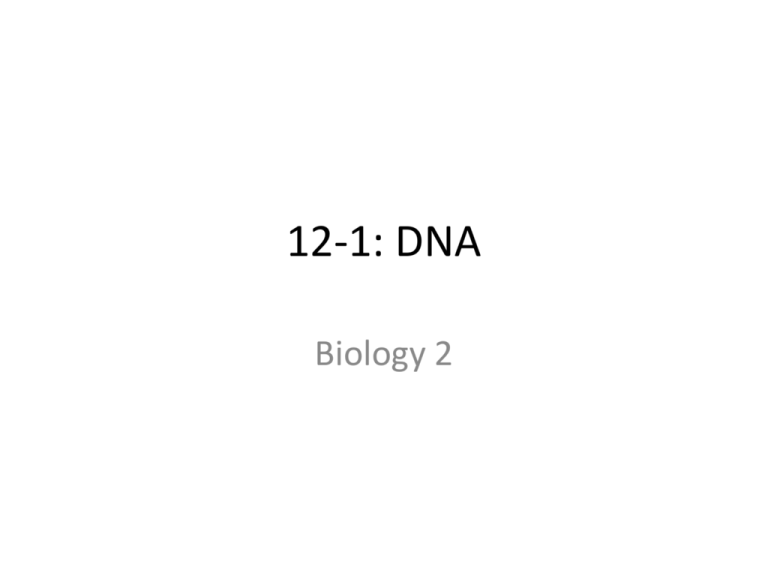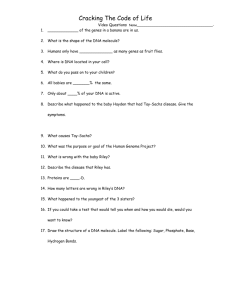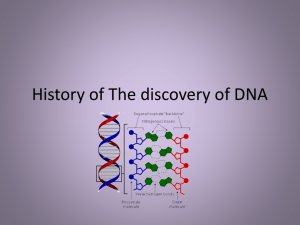DNA Notes
advertisement

12-1: DNA Biology 2 Introduction • In the mid 1900’s biologists wondered: • How do genes work? • What are they made of? • How do they determine characteristics? • Are they single molecules? Introduction • Biologists needed to discover the chemical nature of genes • If they could figure out how genes carried genetic information, could understand how genes control characteristics of living things Griffith and Transformation • 1928: Frederick Griffith was trying to figure out what type of pneumonia made people sick • Found 2 different types: smooth and rough – Smooth was deadly; Rough was not • Gave mice shots with different types – Smooth (alone) killed mice – Rough (alone) did not kill mice – Smooth and Rough together killed mice Griffith and Transformation • Figured out that rough was transformed into smooth when together • TRANSFORMATION: process in which one strain of bacteria is changed by a gene or genes from another strain of bacteria • Griffith discovered that the ability to cause disease was inherited by a gene Avery and DNA • 1944: Oswald Avery wanted to repeat Griffith’s experiment • Created a “juice” from heatkilled bacteria • Used enzyme that would destroy DNA • Transformation did not happen! • Avery discovered that DNA stores/transmits genetic info HerseyChase Experiment • 1952: Alfred Hersey and Martha Chase were interested in which part of a virus could infect cells • Used bacteriophages for experiment to study infection • BACTERIOPHAGE: virus that infects bacteria • Used radioactive markers on outside protein coat and DNA • Discovered genetic material of bateriophage was DNA (not outside protein coat) Components and Structure of DNA • DNA had to be able to: 1. Genes had to carry information to next generation 2. Had to determine characteristics that can be inherited 3. Be easy to copy each time cell divides Components and Structure of DNA • DNA is made of building blocks called nucleotides • NUCLEOTIDES: monomer of nucleic acids made up of a 5carbon sugar, a phosphate group, and a nitrogenous base • Can have 4 different types of base: – Adenine – Guanine – Thymine – Cytosine Components and Structure of DNA • Backbone of DNA is sugar and phosphate groups • FORM THE OUTSIDE OF THE “LADDER” • Bases bond together to connect inside • FORM THE INSIDE (STEPS) OF THE LADDER PHOSPHATE SUGAR BASE Components and Structure of DNA • Shape of DNA is called “Double Helix” – Looks like a twisted ladder! • Discovered by Francis Crick and James Watson in 1953 • Chargaff’s Rule says that base pairs will always have equal numbers – Adenine = Thymine – Cytosine = Guanine Section Assessment 1. ___________: process in which one strain of bacteria is changed by a gene or genes from another strain of bacteria 2. DNA can have 4 different types of bases: ___________, ___________, ___________, ___________ 3. Shape of DNA is called “___________” 4. Chargaff’s Rule says that ___________ will always have ___________







